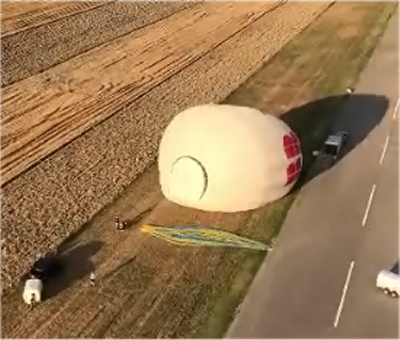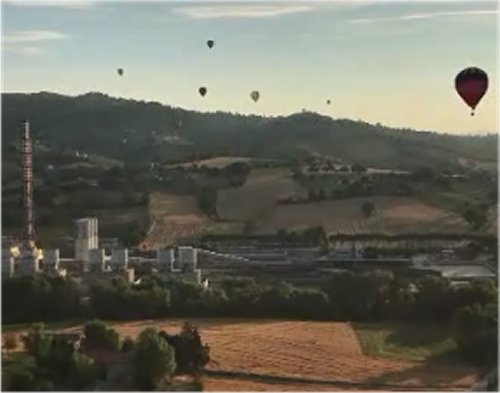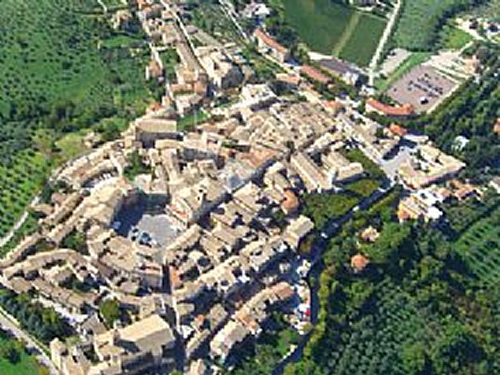
Reminders of Montefalco's Connection with Falcons
|
Montefalco today is almost entirely enclosed by double city walls, dating from the 13th and 14th century and surmounted by towers through which the gates open. Cinta Duecentesca, 13th century walls, is the name given to the compact city-walls restored in the 14th century by Lorenzo Maitani, which are still in good order today. The most impressive of the gates is the "Gate of St. Augustine", which is dominated by an imposing crenelated tower and houses, and under the arch of the gate is a 14th century fresco of "Madonna in Majesty". The other gates are the "Gate of Frederick II" (1244, built to commemorate the emperor's stay in Montefalco) and the 13th century Camiano Gate.

Rickety Climb up to Palazzo De Cuppis o Camilli
|
I entered the town through the Camiano Gate, and climbed the steep Via Porta Camiano up to the town square, the Piazza del Comune. Almost circular in shape, the Piazza del Comune, to which the rest of the streets spoke out from offers a concentration of aristocratic palaces such as the 14th century Palazzo Pambuffetti, Palazzo Senili and Palazzo Santi-Gentili (15th century), Palazzo Langeli and Palazzo De Cuppis o Camilli (16th century). The Town Hall, Palazzo Comunale, was constructed in 1270, then embellished with a loggia, and in the 18th century the bell tower, Torre Campanaria, was added and topped with a fastigium to modify the facade. Across the square is the small, red church of S. Maria de Platea one of the oldest buildings in town, used to hold the first public meetings of the commune.
I walked down the northern arm of Corso Goffredo Mameli, passing by a rickety entrance into the Palazzo De Cuppis o Camilli, and came to the historically important church of San Francesco. Built between 1335 and 1338 by the Order of Friars Minor, the Saint Francis Church was renovated in 1385. The attached monastery houses the Museo Communale, and both buildings are now part of the well-organised Museo di San Francesco, and, given its collection of art and artefact displaying artwork salvaged from other local churches, is one of the most important museums in Umbria. The church is notable for its fresco cycle on the life of St. Francis, by the Florentine artist Benozzo Gozzoli (1450-1452). Other artists represented in the museum include Perugino, Francesco Melanzio, Pier Antonio Mezzastris, Antoniazzo Romano and Tiberio d'Assisi.
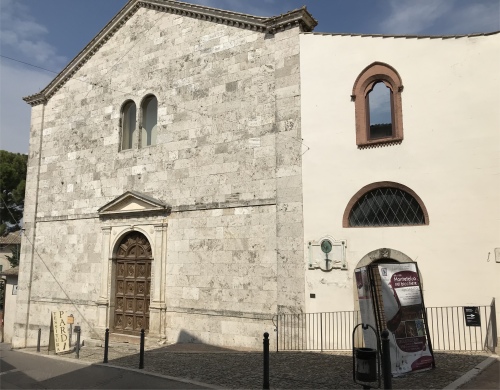
Museo di San Francesco with the Church of San Francesco on the Left
|
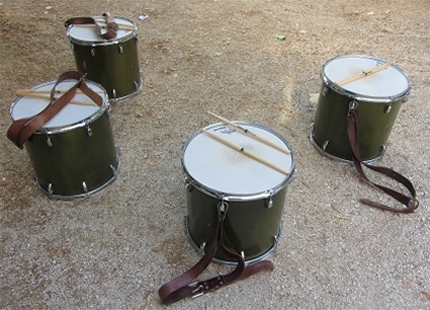
Silent Drums Outside St. Augustine's Church
|
I ambled along by ancient walls, cobbled streets and stone buildings, passing lovely examples of medieval architecture preserved in beautiful churches. Shy cats crept out of sight of passers-by. Many small shops abounded the town, more often than not selling local products. Apart from having a distinction as a popular wine producing region of Umbria, Montefalco is also known for some of its local oil, honey, and salami. The olive oil found here is of a yellow green colour and has a fruity flavour. Besides, the age-old tradition and techniques used in preserving, honey helps in maintaining the rich taste and flavour and makes it a popular product of this region. Some of the other renowned product offerings of Montefalco include cheese, legumes, and pork. Textiles inspired by traditional designs are also produced her. Natural fibres such as linen and cotton are mainly used, with the typical 'jacquard' processing. This is how sheets, bedspreads, towels, curtains, tablecloths and dishcloths are made.
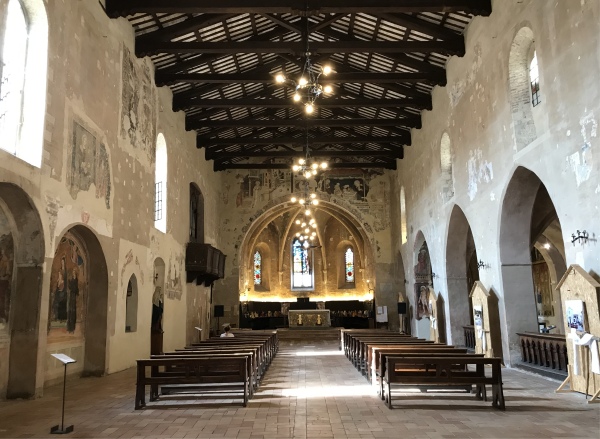
Interior of St. Augustine's Church
|
On my explore I stumbled across the Church of St. Augustine, The church was built between 1279 and 1285 and has a gothic style fašade enriched by an ogival portal. The interior, with two aisles, contains valuable works such as a 15th century wooden statue, a renaissance style wooden crucifix (on the altar), frescoes from the second half of the 15th century by Jacopo di Vinciolo, and several other artworks. I must admit I took refuge in there to escape the heat.
Not far from the church stood the impressive "Gate of St. Augustine", dominated by an imposing crenelated tower. It was too hot to tramp around town further, so I gave John a call, I knew he and Fiona were intending to come up to town for a drink. They were already in town, and I met up with them for a drink and chin wag in the square. Quite unexpectedly, a friend John had met some time before came across to greet us. She was British by birth, but now lived in Antwerp, and often came to this region to visit. This lady was a mine of information, pointing out when the festivals were held, "Not a good idea to have a room near the town centre when they are on," she lamented. She also recommended an excellent restaurant, run by sisters, L'Alchimista. She just burst forth with enthusiasm for the town, quite heart-warming.

Gate of St. Augustine
|
In the evening we all went to Gualdo Cottaneo for an evening soiree by the La Rocca Sonora. This was a delightful venue, set in a large courtyard in the shadow of a huge circular fortified tower. Many of the balloonists were gathered here for a sumptuous buffet with gallons of Prosecco and wine available for the asking. A young fellow greeted us as we entered the courtyard, a very warm, affable chap. We found out later that he was the local mayor.
John, Fiona and I, forever gluttons for punishment, climbed the tower; it was blowing a gale on the top viewing area. We were surprised to see a young woman appear who had managed to scale the narrow, uneven spiral staircase to the top in stilettos, grasping a glass of Prosecco in her hand. How she managed it I'll never know. She posed around - look at me, look at me, but a sudden gust of wind took the pout off her lips as her glass went spinning across the roof. The view from this eyrie was spectacular: including Montefalco basking in the golden glow of sunset in the distance and the Parco Acquarossa airfield nestled in its dusky valley.
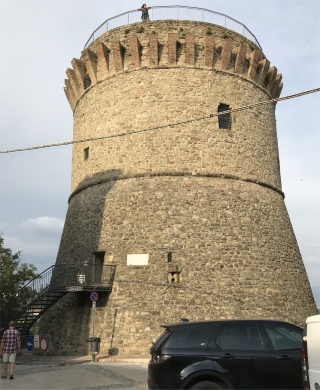
La Rocca
|

Gualdo Cotteneo Rooftops
|
The imposing old Castle of Gualdo Cattaneo, the Rocca Sonora, rises on the north-western margins of the area that in ancient times used to be under the political power of Spoleto, and for ages was hotly contested between Foligno and Spoleto. Its origins probably date back to 975 AD, and are an example of military architecture with a triangular floor plan. Every vertex of the fortress corresponds to a circular trunk-conic tower that communicates with the other towers through underground passageways. The Rocca, which preserves its original aspect and inside has preserved its irregularly arranged rooms, where it is possible to identify the original purpose.
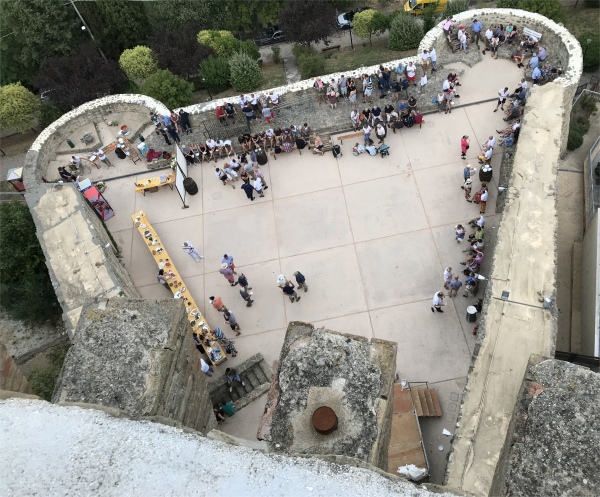
Gathering Below in La Rocca Sonora
|
The imposing tower was designed by Francesco di Bartolomeo da Pietrasanta in 1493 to defend the castle from potential invasions. Work on the fortress began in 1494 and incorporated new solutions to counter the guns that caused serious damage to both structures and defenders. Pietrasanta proposed a solution that included a tower with a circular section, which was connected by walls forming two sides of an isosceles triangle, to allow the defenders a total control of the fortress. The fortress, called "Of the Borgias" in honour of Pope Alexander VI, was completed in 1500 and different skilled workers contributed to its construction. Specialized workers from Tuscany and Lombardy were used in the building of the fortress at Gualdo Cattaneo. Pietrasanta was an important sculptor and architect who spent the last few years of his life in Umbria, at which time he was responsible for several buildings including part of the Basilica of San Francesco in Assisi.
Entering the 16th century, the fortress of Gualdo ceased to be needed as a military structure and was transformed into a residence for the Cardinal Legates in charge of city government. Over the course of the centuries the castle was completely restored and these days it is often used for exhibitions and conferences. Apparently, in 1624 Galileo Galilei stayed here and wrote "It's a small compendium of the universe".
The highest tower has a base with a circumference of 80 metres and a height of 20 metres. It dominates the entire village and is made up of 5 floors hosting all the living facilities necessary to defend and reside in the garrison. As we descended the tower, we visited small exhibitions in various rooms, and wandered through a complete labyrinth of passageways which eventually brought us out into the courtyard.

Montefalco from Gualdo Cotteneo
|

Parco Acquarossa Airfield
|
Back in the gathering I got chattering with Graham, a New Zealander who now lives in England. He left New Zealand at the age of 19, spent some time in Australia, went back to New Zealand, and then came to Britain in 1978. He has stayed ever since in Sussex. "Sussex is much like New Zealand," he told me, "rolling hills, and when it rains there it is sunny in New Zealand, and when it rains in New Zealand, it is dry in Sussex." He was a bright, down to earth sunny chap, with a sense of humour and a glint of mischief in his eye. He loved the UK and was well travelled in the country. He seemed a passionate Briton, and he believed that Britain would suffer an initial hard time after Brexit, but the country would eventually rise again. He pointed out that New Zealand, Australia and Canada had a hard time when they were dumped by the UK when it joined the European Union, but they managed to pick themselves up again and adjust their practices to suit different market requirements.
Graham knew the Suffolk coastal area surprisingly well, his wife had family living there who did a lot of sailing, so we shared stories of the towns and estuaries. When I shared my love of New Zealand from my long stint there 2011/2012, our discussion touched on the aftermath of the Christchurch earthquake, and he greatly enlightened me on some of the nastier sides of liquefaction which had never been explained to me before.
But the event was closing after the mayors speech, so we bade our farewells and returned to base for a pleasant beer and chin wag. The rapidly chilling air warned of the storm to come.
